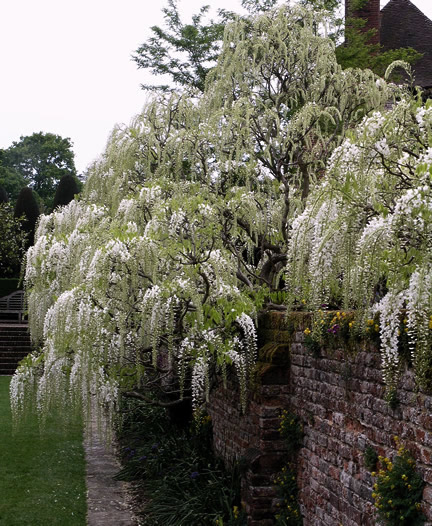| General Description | A beautiful vine, propagates very easily but can become quite invasive in the warmer reaches of our climate (USDA zone 7 +). The blossoms always appear in pendulous racemes and are typically 30 cm in length. |
| ID Characteristic | It can grow to a height of 10 m, and has flower racemes up to 30 cm in length. Individual clusters of flower can open all at once creating a wonderful display of bloom with a slight fragrance. |
| Shape | Multi trunked but can also be trained to grow with one single trunk. Often placed alongside porches or on arbours. |
| Landscape | Woody ornamental vine that is able to twine or trail on the ground. Often used over a garden arbour and creates a perfect focal point in landscape when in bloom. |
| Propagation | When seeds are fresh and ripe in the autumn they may be direct sown and should germinate in the spring. If the seeds are dry, pre-soak and sow them into loamy soil in the greenhouse in early spring. |
| Cultivation | Enjoys moist but well drained soils, flourishes in full sun but tolerates partial shade. |
| Pests | None of note. |
| Notable Specimens | Niagara Parks Botanical Gardens, Niagara Falls, Ontario, Canada. |
| Habitat | Open woods, sometimes seen along roadsides and forest edges in Japan and China. A widely cultivated species. |
| Bark/Stem Description | The bark is rough and light grey to tan in colour. |
| Flower/Leaf Bud Description | Woolly, brown 0.5-2 cm long. |
| Leaf Description | The leaves are compound and about 30 cm in length, usually consisting of 7-13 leaflets. |
| Flower Description | Flowers are pendulous racemes and are aesthetically pleasing. They are typically white in colour. Racemes are 10 - 50 cm long and 8 -10 cm wide. |
| Fruit Description | Green seed pods turning beige at maturity, 10 - 15 cm in length. Pods tend to taper toward their base. |
| Colour Description | Spring blossoms are white in colour. |
| Texture Description | Medium coarse texture. |
